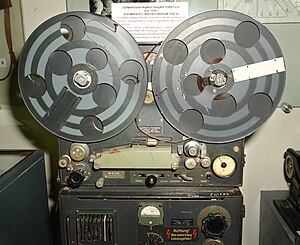Magnetophon

Magnetophon was the brand or model name of the pioneering
Later models introduced the concept of AC tape bias, which improved the sound quality by largely eliminating background hiss. The resulting reproduction was so great an advance on any existing recording method that even those well acquainted with the industry could not tell the recordings from live play. Adolf Hitler used these machines to perform what appeared to be live broadcasts from one city while he was in another. A cache of 350 of these tapes was released years later when they were found in Koblenz.[4]
Two later model Magnetophons were taken to the United States after the war, having been found in
History
The Magnetophon tape recorder was one of the first recording machines to use magnetic tape in preserving voice and music. At first, early Magnetophons gave disappointing results. One of the first concerts to be recorded on a Magnetophon was Mozart's
Later in 1939, the Fe3O4 oxide was replaced by the Fe2O3 type, which gave a significantly better recording quality, so much that the formula became a worldwide standard until the 1970s when chromium dioxide tapes appeared.
Adding a
Many speeches, concerts, and operatic performances were recorded. Since many of the recordings survived World War II they were later issued on LPs and compact discs. One of the more remarkable series of recordings took place at the Vienna State Opera House, also known as
AEG engineers made rapid strides in perfecting the system and had practical
Magnetophon recorders were widely used in German radio broadcasts during World War II, although they were a closely guarded secret at the time. The Allies were aware of the existence of the pre-war Magnetophon recorders, but not of the introduction of high-frequency bias and PVC-backed tape.[9] Their intelligence experts knew that the Germans had some new form of recording system but they did not know the full details of its construction and operation until working models of the Magnetophon were discovered during the Allied invasion of Germany during 1944-45.
American audio engineer Jack Mullin acquired two Magnetophon recorders and fifty reels of magnetic tape from a German radio station at Bad Nauheim near Frankfurt in 1945. The allied forces were traveling through Germany during WWII when they first discovered the device. The Allies then handed the Magnetophon over to Mullin.[10] Over the next two years Mullin modified and developed these machines, hoping to create a commercial recording system that could be used by movie studios. American popular vocalist Bing Crosby, dissatisfied with the quality of existing radio network recordings was prevailed upon to invest in this development and would use the technology, as modified by Mullin and the fledgling Ampex company, to record his radio broadcasts in the more relaxed atmosphere of the recording studio, which was a significant break from the then-norm of live studio audience broadcasts. In 2008, at the 50th Annual Grammy Awards Ceremony, Ampex received the company's first Grammy Award for Technical Achievement, to honor their contribution sixty years earlier of the Ampex 200, which "revolutionized the radio and recording industries". Ampex 200 co-designer Myron Stolaroff was among the company's employees representing Ampex who accepted the award.[11]
As a generic noun
Magnetophon became the
See also
References
- ^ History Department at the University of San Diego. "Magnetic Recording History Pictures". Archived from the original on May 9, 2008.
- ^ "1935 AEG Magnetophon Tape Recorder". MIX. Penton Media Inc. September 1, 2006. Archived from the original on 8 February 2013. Retrieved 18 June 2010.
- ^ Engel, Friedrich Karl; Peter Hammar (2006-08-27). "A Selected History of Magnetic Recording" (PDF). Retrieved 18 June 2010.
A brief history of magnetic tape from the BASF Historian and the founding curator of the Ampex museum. - ^ Fox, Barry (9 February 1984). "The real history of tape recording". New Scientist: 45.
- ^ "Stanford Libraries' Ampex Model 200A Magnetic Tape Recorder, Restored by Larry Miller". Audio Engineering Society. AES. Retrieved 5 February 2016.
- ^ "Ampex 200A - 1947-1948, Ampex 300 - 1949". Museum of Magnetic Sound Recording. MOMSR. Retrieved 5 February 2016.
- ^ BASF LP releases
- ^ "Beethoven: Piano Concertos / Gieseking"
- ^ Information from 'BBC Engineering 1922-1972' by Edward Pawley, page 387.
- ISBN 0-19-500475-2.
- ^ "Ampex Honored at 50th Annual Grammy Awards Ceremony: Recognized for Outstanding Technical Achievement". businesswire.com. Business Wire. Retrieved 5 February 2016.
Sources
- Barnouw, Erik (1968). A History of broadcasting in the United States ([Verschiedene Aufl.] ed.). New York: Oxford University Press. ISBN 0-19-500475-2.
- Friedrich K. Engel, "Chapter 5: The Introduction of the Magnetophon". In Daniel, Eric D.; et al. (1999). Magnetic recording: the first 100 years. Wiley-IEEE. ISBN 0-7803-4709-9
